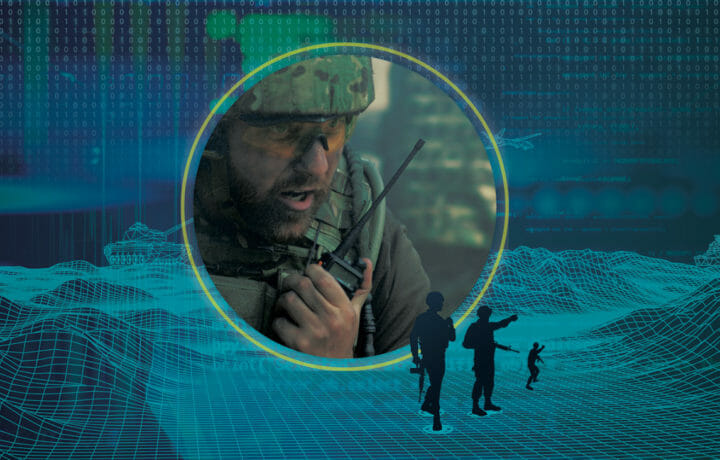Modular, scalable system for command and control enhances data sharing
Soldiers and airmen are on the ground and in the air, awaiting your orders. In front of you, at the heart of your decision making, a 3D picture of the entire Joint All-Domain operational environment displays friendly and hostile aircraft in the skies and troop movements on the ground.
These images spring from your command and control (C2) equipment, which connects leaders in your operations centers to warfighters all around the globe. By providing visualization of the battlespace across multiple environmental planes, C2 is critical to mission success in the digital battlespace.
To address today’s adversarial threats where any large physical presence—an installation or sizable caravan transporting equipment—may be a target, the nation’s military is striving for more agile, deployable, and survivable C2 capabilities. Scaling the physical presence of C2 equipment and making it faster to set up and break down, is essential to effective agile deployment and providing warfighters the C2 picture they need in the time they need it.
At Northern Strike 2021 (NS21) in Camp Grayling, MI, Booz Allen Hamilton debuted a modular, tailorable, and scalable approach to streamlined, open C2 technology that could soon become the standard. Working in partnership with the Michigan National Guard and innovative new-generation equipment suppliers, Booz Allen is connecting C2 systems for faster deployment and better situational awareness worldwide.
More Nimble Deployment and More Capabilities
At just a quarter the size of legacy technology, Booz Allen’s new modular detachment kit (MDK) C2 system sets up in a fraction of the time. Its modules can be scaled up or down depending on capacity demands and tailored at the sub-component level depending on operational needs. The modules can be placed in various locations across the globe, enabling C2 data to move more quickly and easily across strategic, operational, and tactical levels.
“MDK is a meaningful, fieldable military capability that can be put in the hands of operators today to simplify operations through its modular, tailorable, scalable, and highly mobile approach,” said Khalid Syed, Booz Allen senior vice president and leader of the firm’s command, control, communications, computers, cyber, intelligence, surveillance and reconnaissance (C5ISR) and integrated air defense (IAD) business. “It’s not just more efficient—MDK provides a clearer picture of the Joint All-Domain environment because it seamlessly integrates with virtually any sensor, communications system, and C2 system in the field, which is crucial to achieving information superiority in the digital battlespace.”
MDK’s eight tailorable modules provide the most comprehensive and informative operational picture to the nation’s military anywhere in the world. They equip warfighters with sensor ingestion, fusion, and tracking (connecting radars over the horizon), mode 5 interrogation, datalink (e.g., link 16, enhanced position location reporting system), radio frequency transmissions, cyber transport/satellite communications, communications administration, and power production. MDK is designed to be scalable from a single laptop with basic capabilities to a robust suite of systems that can support a theater-level area of responsibility. Units can hand-carry basic capabilities on commercial airlines or load the full capability in the back of a utility vehicle to the desired operating location.
MDK is based on an open, vendor-agnostic approach—so when the Army, Air Force, or Marines decide on a newer, better, or more advanced tracker, fusion engine, display, or more—MDK can easily host it, enabling operational commanders and warfighters on the ground to rapidly exchange time-critical data faster than ever before.
Demonstrated Success and a Promising Future
Booz Allen demonstrated MDK technology in August at NS21, a live-fly exercise hosted by the National All Domain Warfighting Center (NADWC). The event is one of the largest military exercises on American soil, convening more than 5,000 troops from every branch of service as well as the National Guard, NATO partners, and allied nations.
The exercise displayed MDK’s ability to serve as a scalable principal technology path for the Advanced Battle Management System (ABMS), the Air Force’s effort in achieving Joint All-Domain Command and Control (JADC2). By connecting disparate C2 systems, MDK provided an operational picture for rapid decision making and response. It also enabled delivery of Battle Management Command and Control (BMC2) effects to and through all operational environments. Both capabilities are critical as the need for speed and versatility continues to grow.
“Booz Allen’s engagement during Northern Strike is a prime example of how Michigan’s NADWC is perfectly positioned to support both military and private sector innovation,” said U.S. Army Major General Paul D. Rogers, director, and adjutant general of the Michigan Department of Military and Veterans Affairs. “Our testing and training capabilities provide a premier opportunity for defense industry partners to test emerging technologies and we are excited for what the future has in store as we continue to partner with industry to position Michigan as a leader in this field.”
Learn more about how Booz Allen is empowering warfighters and decision makers in the digital battlespace.
Are you ready to work at the leading edge of innovation?
Explore Careers.
SPONSORED CONTENT: This article is written on or behalf of our Sponsor.




